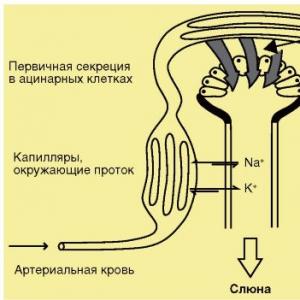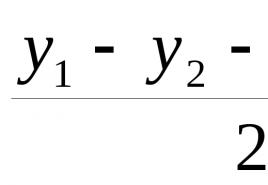Akhtubinskaya taphole. In the Akhtubinsk secondary cadet school - boarding school named after P.O.
The performance characteristics of the GP-25
Caliber ... 40 mm
Shot ... VOG-25, VOG-25P
Weapon weight without a shot ... 1.5 kg
Weapon length ... 323 mm
Barrel length ... 205 mm
Initial speed ... 76 m / s
Effective rate of fire ... 4-5 rds / min
Max, firing range ... 400 m
(flat or mounted fire) Min. mounted firing range ... 200 m
GP-25 underbarrel grenade launcher


The GP-25 underbarrel grenade launcher on the AKM assault rifle
In 1978, the GP-25 "Koster" grenade launcher, created at TsKIB SOO V.N. Teleshem for use in combination with AKM, AKMS, AK 74 and AKS 74 assault rifles. The production of the grenade launcher was established by the Tula Arms Plant.
GP-25 (index 6G15) has a simple device, refers to muzzle-loading rifled systems.
The VOG-25 or VOG-25P caliber fragmentation shot developed by GNPP "Pribor" combines a grenade and a propellant in a sleeve and is inserted into the barrel without effort, entering the barrel's grooves with 12 projections of the leading belt, held in the barrel by a spring-loaded retainer.
The grenade launcher has a hammer-type self-cocking firing mechanism with a flag safety lock that locks the trigger. The grenade launcher is attached to the forend of the assault rifle with a bracket with a fence and is fixed with a latch. To mitigate the effect of recoil on the shooter and the weapon, a rubber butt plate is attached to the butt, the frame of the GP-25 firing mechanism body protects the rifle forend from damage, and the elastic frame liner softens the impact on the receiver. The accessory includes a recoil spring rod with a hook, which replaces the usual guide rod of the machine to prevent the receiver cover from breaking off when fired from the grenade launcher.
The mechanical target-quadrant is designed for direct or semi-direct fire, and a correction for the grenade derivation is automatically introduced. At a distance of 400 m, the mean deviations of the hit are 6.6 m along the range, and 3 m along the front.
The GP-25 with the AKM and AK 74 assault rifles made a successful, compact and easily controlled automatic grenade launcher system. Direct fire is usually carried out: at a distance


A variant of the GP-30 underbarrel grenade launcher developed by TsKIB SOO

Shot VOG-25

Shot VOG-25P
Tactical and technical characteristics
GP-30 (sample 2000)
Caliber ... 40 mm
Shot ... VOG-25, VOG-25P
Weapon weight without firing ... 1.3 kg
Weapon length ... 276 mm
Barrel length ... 205 mm
Initial speed ... 76 m / s
Effective rate of fire ... 5-6 rds / min
Maximum firing range ... 400 m

A loaded GP-25 grenade launcher (on the AK 74 assault rifle) and VOG-25P and VOG-25 rounds

Shooting from an under-barrel grenade launcher (on the AKM machine gun) with an emphasis on the shoulder
up to 200 m - with the butt resting on the shoulder, 200-400 m - with the butt clamped under the arm, and along a steep hinged trajectory - with the butt resting on the ground.
The GP-30 "Obuvka" modification (index 6G21) is distinguished by a 20% reduction in the weight of the grenade launcher itself and a 35% reduction in the labor intensity of production. First of all, the sight is simplified - the plumb line is excluded, the clamping rings are eliminated. The sight itself has been moved to the right side, semi-direct aiming is carried out according to the principle of "equidistant point". TsKIB SOO also developed a new version of the GP-30 with an elongated barrel and a rack-mount sight - the muzzle of the grenade launcher protrudes in front of the flame arrester or compensator on the barrel of the machine gun, which excludes their harmful effect on the flight of the grenade.
A shot of VOG-25 when a grenade falls vertically gives a radius of continuous destruction by fragments of up to 10 m. The instant fuse is unified with the 30-mm VOG-17 shot, there is a self-destructor. The VOG-25P (jumping) round is equipped with an expelling charge; when it falls to the ground, the fragmentation element is thrown out and explodes at a height of 0.5-1.5 m, which enhances its damaging effect. There is a smoke shot GRD-40.
Caliber: 40 mm
Length: GP-25: 320mm, GP-30: 276mm
Weight without grenade: GP-25: 1.5kg, GP-30: 1.3kg
Effective firing range:150 m
The development of an under-barrel grenade launcher to expand the combat capabilities of the infantry began in the USSR in 1975. The development was based on the experience gained in the second half of the 1960s when creating experimental underbarrel grenade launchers on the "Iskra" theme. In 1978, a new grenade launcher under the designation GP-25 was adopted for installation on the AKM, AKMS, AK-74, AK-74S assault rifles. In 1989, an improved GP-30 grenade launcher was adopted, which has a lighter weight and a simpler design.
By device GP-25 and GP-30 - single-shot, muzzle-loaded, with a rifled barrel. The trigger mechanism is self-cocking, with a manual safety catch and automatic blocking of a shot if it is incorrectly installed on the machine.
Grenades for GP-25 and GP-30 have an original "caseless" design with an integral chamber for a propellant charge, "flying away" from the barrel along with the grenade. This solution excludes from the reloading cycle the actions to remove the spent cartridge case, which significantly increases the practical rate of fire of these grenade launchers compared to most Western counterparts.
On the body of the grenade there is a leading belt with ready-made grooves. The main disadvantage of the GP-25 and GP-30 grenade launchers in comparison with their western counterparts is the limited choice of ammunition - only three types of grenades - conventional fragmentation VOG-25 and "jumping" VOG-25P and a "non-lethal" tear gas nail grenade.
Jumping grenade VOG-25P differs in that after hitting the ground at the target it does not immediately explode, but with the help of a special charge "jumps" up about half a meter and explodes in the air, providing more optimal coverage of the target (infantry in a trench or shelter) with fragments. The radius of the effective zone of destruction by fragments for VOG-25 grenades is approximately 5 meters. Effective firing range 100-150 meters.
Modifications
VOG-25IN
GRAU index - 7P17I. A practical shot with a grenade in inert equipment, used for training and training in shooting.
VUS-25
VUS-25 (index 7P45U) - training grenade, used for training and education.
VOG-25P
GRAU index - 7P24, code "Foundling". A shot with a "bouncing" fragmentation grenade, equipped with a VGM-P fuse with an expelling charge and a pyrotechnic retarder. Introduced into service in 1979.
When it hits an obstacle, the shot jumps and explodes in the air at a height of about 1.5 meters. In comparison with VOG-25, "bouncing" ammunition allows you to more effectively hit the enemy lying and located in a trench or trench.
Description:
Caliber: 40 mm
Starting speed:76 m / s
Weight: 275 g
Explosive weight: 42 g
Length:125 mm
Cocking distance:10 - 40 m
Self-liquidation time: not less than 14 s
Average break height:75 cm
"Nail"
40-mm round "Nail" with a gas grenade - designed to create a gas cloud with an intolerable concentration of irritant (irritant) CS. It is in service with the Ministry of Internal Affairs of the Russian Federation.
VDG-40
40-mm shot with a smoke grenade VDG-40 "Nagar" - used for setting up a smoke screen.
VOG-25M
A modernized version of the VOG-25 round with a fragmentation grenade, partially unified with the VOG-25PM. Developed in the early 2000s.
VOG-25PM
A modernized version of the VOG-25P round with a "bouncing" fragmentation grenade, partially unified with the VOG-25M. Developed in the early 2000s.
ASZ-40
40-mm acoustic shot ASZ-40 "Svirel". A non-lethal light and sound grenade serves to temporarily suppress the psycho-volitional stability of the enemy's manpower. It is in service with the Ministry of Internal Affairs of the Russian Federation.
Currently, there is a trend towards a further expansion of the types of ammunition. So, at the international arms exhibition "Defendory-2006" new types of grenades were presented:
GDM-40 - shot with a smoke grenade
VGS-40-1 - flare grenade shot (red fire)
VGS-40-2 - flare grenade shot (green fire)
VG-40I- shot with a lighting grenade
As a result of the work of the teams of designers TsKIB SOO Tula and GNPP "Pribor", Moscow were developed, successfully tested and in 1978, based on the results of PI, the 6G15 grenade launcher was recommended for armament with the CA (later assigned the index GP-25, the theme "Bonfire") and a shot towards him with a VOG-25 fragmentation grenade.
The 40-mm GP-25 grenade launcher is an under-barrel grenade launcher mounted under the barrel of a Kalashnikov assault rifle of all modifications, calibers 5.45 mm and 7.62 mm (except for AK74U), as well as a 5.45 mm Nikonov assault rifle (AN94, theme "Abakan", ind. 6PZZ) and is designed to combat open manpower, as well as manpower located in open trenches, trenches and on the reverse slopes of the terrain.
The grenade launcher includes the following main assembly units:
- barrel with bracket; body with breech; receiver cover fixation unit; butt pad with a belt.
The set of the grenade launcher also includes a bannik for cleaning and lubricating the barrel.

The grenade launcher is loaded with a shot from the muzzle of the barrel. The shot must be inserted into the barrel until it stops at the end of the breech. In this case, the shot in the barrel is fixed with a special lock, which, in turn, is connected to the transmission lever, which blocks the trigger in such a way that, if the shot is not fully sent, the firing becomes impossible. The design of the grenade launcher also includes a device that blocks the firing mechanism, which excludes the possibility of firing from a grenade launcher that is not attached or not fully attached to the machine gun (the locking mechanism is automatically turned off when the grenade launcher is correctly positioned and fixed on the machine).

The firing mechanism of the grenade launcher is a self-cocking type. In addition, the grenade launcher is equipped with a conventional flag-type fuse, which excludes accidental shots when the grenade launcher is loaded.
The grenade launcher uses an open-type mechanical sight, which allows aimed shooting at ranges from 100 m to 400 m. The sight is located to the left of the assault rifle's aiming line, the sight scale (resolution 50 m) is located at the bottom, the sight is fixed at the desired angle using a mechanism such as " ratchets ". The sight has a plumb line to give the grenade launcher barrel the required elevation angle when firing at an invisible target (for example, on reverse slopes of a hill, etc.) and a scale for hinged firing (at elevation angles of the barrel over 45 °) at ranges from 200 to 400 meters. In order to ensure hinged firing at a minimum range (100 meters), a crane device was introduced into the design of the grenade launcher. When the valve is open, part of the propellant gases from the combustion of the propellant charge are discharged from the bore into the atmosphere and, thereby, the initial flight speed of the grenade decreases (from 76 m / s to 55 m / s). However, the results of military tests revealed the inexpediency of having a crane and, in the future, in the production of grenade launchers, the crane device was excluded from the design, and the minimum firing range for mounted firing increased to 200 meters.

Depending on the assigned combat mission, the firing range and the characteristics of the firing position, the submachine gunner can fire from the following positions:
- lying down; from the knee from the shoulder, from under the arm, with the butt resting on the ground; sitting from under the arm or with the butt resting on the ground; standing from the shoulder or from under the arm.
If necessary, the grenade launcher can be easily discharged using a special extractor.

The standard 40-mm VOG-25 (7P17) round is unitary in design and is made according to a "caseless" scheme, i.e. the propellant charge together with the ignition means is located in the bottom of the grenade body. Such a shot scheme was used for the first time in domestic practice. It made it possible to greatly simplify the design of the grenade launcher and, accordingly, to increase the reliability of the functioning of the weapon, coupled with an increase in the combat rate of fire. Shot grenade - fragmentation grenade with a steel body. Inside the body of the grenade (between the explosive charge and the body) there is a cardboard grid for rational crushing of the body into fragments, which contributes to an increase in the fragmentation effect. It is just necessary to note here that the VOG-25 shot grenade is 1.5 times more effective at the target than the OFZ 30-mm round for the 2A42 cannon, which is equipped with the BMP-2.
Outside the body of the grenade, ready-made grooves are made, which serve to give the grenade a rotational motion (the grenade is stabilized in flight due to rotation) during its movement along the bore. The grenade fuse (index VMG-K) is a head, shock, instant and inertial action, semi-safety type with long-range pyrotechnic cocking and self-destruct. The cocking distance is from 10 to 40 meters from the muzzle of the grenade launcher. Such a significant spread is due to the temperature range of the weapon's use (from minus 40 ° C to 50 ° C). The response time of the self-destruction mechanism -14-19 sec.
In 1978, comparative tests of the GP-25 grenade launcher with a VOG-25 shot and a 40-mm M-203 grenade launcher mounted on an M16 rifle with an M-406 shot were carried out. The tests showed a significant advantage of the domestic grenade launcher and the shot to it over a similar system made in the United States. To install the M-203 grenade launcher on the M16A1 rifle, incomplete disassembly of the latter is required, and to load the grenade launcher, three operations are required manually (in contrast to the GP-25, where one operation is necessary for this purpose - to send a grenade into the barrel): - disconnect the grenade launcher barrel from breech, pushing it forward (while the sleeve is extracted from the previous shot); - insert a new shot into the barrel (shots for the M-203 grenade launcher are made according to the classic "unitary" scheme with a sleeve separating after the shot); - connect the barrel to the breech of the grenade launcher. It is quite obvious that performing three operations instead of one for loading the weapon leads to a decrease in its rate of fire.
The VOG-25 and M-406 shots were compared with shooting at the terrain where the target environment was located, simulating openly located manpower (lying growth targets). During these tests, it was revealed that the frequency of hitting targets in the tactical field from the rupture of a VOG-25 shot grenade is 3-4 times higher than from the rupture of a fragmentation grenade from an M-406 shot.
While the designers from TsKIB SOO designed the GP-25 grenade launcher, namely in 1974, a new task was set for their colleagues from the GNPP Pribor. It was necessary to develop a new 40-mm round for an under-barrel grenade launcher with an increased effectiveness of fragmentation action against buried and unprotected shelters (trenches, trenches, stones, etc.) manpower, in comparison with the VOG-25 shot grenade, in 1 , 5-2 times (without reducing the effectiveness of the fragmentation action for growth targets). This, frankly speaking, not an easy technical problem was brilliantly solved by the team of designers of the GNPP "Pribor". In 1979, a new 40-mm round with a VOG-25P fragmentation grenade ("Foundling", index 7P24) was presented for field trials, and in the same year a new shot was recommended for armament by the SA. The main and main difference between the new shot was in the head fuse, which received the VMG-P index.

An expelling charge and a pyrotechnic retarder were introduced into the design of the VMG-P fuse, which ensured the "bouncing" of the grenade after hitting the ground and its rupture in the air when firing at all "ranges of combat use of the grenade launcher. 75 m, which made it possible to increase the effectiveness of the fragmentation action in comparison with the VOG-25 shot grenade.
GP-25 underbarrel grenade launcher / Photo: EastArms.ru
In accordance with the existing classification, an under-barrel grenade launcher is a type of a rifle grenade launcher located under the barrel of the main weapon.

GP-25 underbarrel grenade launcher / Photo: vpk-news.ru
Rifle grenade launchers, as a means of increasing tactical independence and firepower of small infantry units, were created during the First World War. The first rifle grenade launchers were fixed on the muzzle of the barrel and received the name - muzzle grenade launchers. For firing a grenade, special blank cartridges were used.
In the USSR in 1928, the Dyakonov grenade launcher was adopted, which was fixed on the muzzle of the 7.62-mm rifle mod. 1891/30 However, the inconvenience of its use, the low efficiency of a remote-action fragmentation grenade, as well as the need to remove the grenade launcher before firing a live cartridge from a rifle, limited its use in battle.
In 1944-45. in the USSR, the VG-44 grenade launchers for the 7.62-mm carbine mod. 1944 g and VG-45 for the 7.62 mm SKS carbine. For firing grenade launchers, 40-mm cumulative (VPG-1) and fragmentation (VOG-1) grenades were used. These grenade launchers were also attached to the muzzle of the carbines, and special blank cartridges were used to fire the grenade. Due to the low efficiency, and primarily the small power of the grenades, these grenade launcher systems were not widely used.
Before the Second World War, rifle grenades were also created in the USSR. In 1941, an anti-tank rifle grenade of the Serdyukov system VPGS-41 of the ramrod type entered service. However, due to the unreliability and unsafeness of the grenade, as well as the low accuracy of fire, it was withdrawn from service in 1942.
Evaluating the above developments, it should be noted that one of the main problems that were not resolved at that time was the creation of a reliable and effective grenade in a small caliber, determined by the weight and size requirements for the wearable weapon.
The first experiments to create a new combined multipurpose weapon, devoid of the drawbacks of muzzle grenade launchers and rifle grenades, began in the USSR in the early 1960s. Similar work was carried out at this time in the United States.
An employee of the Central Design Bureau of Sports and Hunting Weapons (TsKIB SOO, Tula) KV Demidov proposed a new two-stage ballistic scheme of an underbarrel grenade launcher. The essence of the proposal was that in the bottom of the grenade there was a shank with a propellant charge of a smaller diameter than the grenade itself. The shank, like a piston, was introduced into the high-pressure chamber of the grenade launcher. The pressure in this chamber was several times higher than the pressure in the caliber part of the barrel, which made it possible to increase the loading density, ensure the early combustion of the propellant charge and the stable characteristics of the shot.
Work on the creation of the first domestic grenade launcher was initiated on an initiative basis in TsKIB SOO in 1965 by K.V. Demidov together with V.V. Rebrikov. The manufactured prototypes were demonstrated to representatives of the USSR Ministry of Defense, and in April 1967 the Iskra R&D project was launched to develop a “Firing device and a shot with a fragmentation-cumulative grenade for the AKM assault rifle”. Also in TsKIB SOO, preliminary design studies of a 40-mm cumulative fragmentation round were carried out.
However, the required characteristics of the power of the grenade and the accuracy of fire were not achieved, and work on the Iskra design and development project was stopped. The reasons for the failure were the incorrectly specified requirements for the grenade launcher and the not entirely successful design of the grenade itself.
Nevertheless, the positive experience of using this type of weapon by the US army in Vietnam forced to resume work. The Ministry of Defense assigned the designers the task of creating a weapon that surpasses the American M203 grenade launcher in a number of indicators.
As a result, in 1971, the "Koster" development work was started to create an under-barrel complex with a fragmentation grenade. TsKIB SOO was identified as the lead developer of the complex and the grenade launcher, the lead developer of shots was NPO Pribor, the developer of fuses for grenades was the Scientific Research Technological Institute, and the developer of propelling and expelling charges was Kazan NIIHP.
The transfer of the development of the ammunition of the new grenade launcher complex to a specialized enterprise and ultimately determined the success of the promising development.
As a result of the ROC "Koster", a grenade launcher system was created and adopted in 1978 by the Soviet Army, consisting of a 40-mm GP-25 grenade launcher (lead designer V.N. Telesh) and shots to it with a VOG-25 fragmentation grenade and with a VOG-25P "bouncing" fragmentation grenade. The grenade launcher is fixed under the barrel of AKM, AKMS, AK74 and AKS74 assault rifles.
The grenade launcher has a rifled barrel. The self-cocking firing mechanism of the grenade launcher ensures high combat readiness of the complex and the safety of carrying in a charged state. Flag-type fuse, when it is on, locks the trigger. For the convenience of handling the grenade launcher, a pistol grip is attached to the firing mechanism body. The grenade launcher is loaded from the muzzle, and unloaded by pressing the extractor. The grenade is held in the barrel by a spring-loaded retainer, which at the same time serves as a safety catch when the grenade is not fully loaded into the barrel.
The muzzle loading of the grenade launcher, as well as the absence of a cartridge case, make it possible to fire up to 6 aimed shots per minute. The open-type sighting device is located on the left side of the grenade launcher and provides direct and semi-direct fire (along a hinged trajectory). When firing along a mounted trajectory at unobserved targets (in trenches, in ravines or on reverse slopes of heights), the required elevation angle of the weapon is given along the plumb line of the sight. The derivation of the grenade is automatically taken into account in the scope when the scope is installed.
A rubber butt plate is installed on the butt of the machine gun to weaken the impact of the recoil of the grenade launcher on the shooter's shoulder, as well as to reduce the forces perceived by the butt when firing against solid ground.
Unlike the American prototype, when developing the Soviet grenade launcher, the designers, not being associated with the old ammunition, decided to create a shot of a fundamentally new design based on the proposals of K.V. Demidov.
The two-chamber ballistic engine, which is formed by the grenade shank and the breech of the grenade launcher, provided, at almost equal muzzle velocity with the American counterpart, a decrease in recoil and the possibility of increasing the mass of a fragmentation grenade. In addition, the placement of a propellant charge in the grenade shank excluded such an operation as the extraction of the spent cartridge case. After the next shot, the shooter only has to get the next grenade out of the bag, insert it into the muzzle of the grenade launcher and push it all the way into the barrel by pressing.

The production of the grenade launcher was mastered by the Tula Arms Plant. Infantrymen, armed with small arms and grenade launchers, were able to hit manpower and fire weapons, not only openly located, but also located in open field shelters and behind various obstacles. Subsequently, in addition to fragmentation grenades, the creation of other types of grenades for various purposes and destructive action significantly expanded the infantry's capabilities to defeat the enemy.
A 40-mm round with a VOG-25 fragmentation grenade has a grenade with protrusions on the leading belt. This made it possible to stabilize the flight of the grenade by rotation, without creating excessive pressure in the barrel bore and to make the grenade launcher relatively light. Head fuse with long-range cocking (10-40 m from the muzzle) and self-destruct. It ensures the safety of handling a grenade during transportation and its instant detonation when it hits an obstacle. The radius of continuous destruction by fragments generated from the organized crushing of the hull is 6 m.
In addition to the VOG-25 round, in order to increase the effectiveness of the defeat of manpower in open-type structures and in the terrain lying behind shelters, a shot with a "bouncing" grenade - VOG-25P was developed and adopted for service. When it hits the ground and the fuse is triggered, a special charge is detonated. He throws a grenade to a height of 0.5-1.5 m, where the main charge is detonated. When a grenade explodes in the air, the density of the fragmentation field and the likelihood of hitting the target significantly increase.
In the early 2000s, NPO Pribor developed modernized VOG-25M and VOG-25PM rounds to replace VOG-25 and VOG-25P shots. They have a new unified body with organized crushing during blasting. The number of fragments and their energy provide a 1.5 times greater probability of hitting live targets than that of VOG-25 grenades. The VOG-25PM grenade, like the VOG-25P grenade, has a special charge that provides a toss of a grenade over the ground before detonating.

GP-25 grenade launcher ammunition / Photo: vpk-news.ru
The fuse mechanism of new grenades ensures its cocking 10–40 m from the muzzle of the grenade launcher and their reliable detonation when meeting with various obstacles, including snow and water surface. If the fuse fails, the grenade self-destructs within 14–19 s. The fuse ensures the safety of handling a grenade loaded into a grenade launcher.
To increase the tactical independence of small infantry units and to perform special tasks by various law enforcement agencies, which are armed with grenade launchers, in the first decade of the 2000s at the Federal State Unitary Enterprise "FNPC" Pribor "and at the Scientific Research Institute of Applied Chemistry (NIIPKh, Sergiev Posad), a range of ammunition of various special purpose - shots with high-explosive, thermobaric, incendiary, light-sound, lighting and signal grenades.
Shots VFG-25 with a high-explosive and VG-40TB with a thermobaric warhead ensure the defeat of the enemy located in open areas, in field-type shelters, in various rooms, in fortifications and behind natural obstacles. In addition, they can be guaranteed to destroy objects of unarmored vehicles. The peculiarity of the action of these grenades lies in the fact that they have a multifactorial defeat: high-explosive, fragmentation and incendiary. Thanks to this, their high efficiency is ensured in the destruction of enemy manpower and his unarmored targets.
To create smoke screens in open areas, in front of natural and artificial shelters, as well as to create fires on the ground, indoors and in unarmored vehicles containing flammable and flammable materials, 40-mm VZG-25 shots with incendiary, VG-40DZ were developed with smoke-incendiary grenades and GD-40 smoke-forming action. One VZG-25 grenade can provide at least 3 fires with a composition burning temperature of up to 2000 ° C. The VG-40DZ grenade provides for the setting of a continuous smoke screen up to 5 m long and up to 2.5 m high. In addition, a single grenade can create up to 10 fires. The firing range of these grenades is from 50 to 400 meters.
To instantly create a smoke screen in case of need to hide the maneuver of their units, a GDM-40 shot with an instant smoke grenade was created. This grenade provides, within 1 ... 2 seconds after the shot, the formation at a distance of 40 ... 50 m of a continuous aerosol-smoke cloud up to 10 m in length and up to 3 m in height. The cloud's lifetime is 20 ... 30 s, which is quite enough for making a maneuver and getting out of enemy fire.
Temporary neutralization of the enemy is provided by the explosion of light-sound grenades VG-40SZ and GZS-40. A live target is hit by a bright blinding flash and high level sound. At a distance of 10 m from the place where the grenade burst, the sound level is at least 135 dB. The simultaneous impact of these two factors provides a temporary loss of orientation and the suppression of a person's psycho-volitional stability.
To provide light and sound signals and illuminate the terrain when firing from under-barrel grenade launchers, combined shots with a signal cartridge, a special signal cartridge, and parachute-free lighting and parachute cartridges were developed.
The combined signal cartridge for the under-barrel grenade launcher is designed for the simultaneous supply of color fire and reflected radar signals. After a shot from such a cartridge at a height of 300 m, a bright red star lights up, the burning time of which is at least 6 seconds. In addition, when the cartridge is triggered, a cloud of radio-reflecting dipoles with an area of \u200b\u200bat least 10–12 m2 is formed. This cloud provides reception of the reflected radio signal at a distance of at least 10–12 km. The burning of a star can be seen with the naked eye in the daytime at a distance of up to 3 km, and at night - almost 10 km.
The signal cartridge provides a red or green signal. The lifting height of the sprocket is up to 200 m, the burning time is not less than 10 s. Such a signal is visible during the day at a distance of up to 3 km and at night up to 10 km. To provide illumination of the terrain and illumination of targets at night, special parachute and parachute-free lighting cartridges have been developed. Their main difference is the duration of the area illumination, the range and height of the torch setting. Both types of luminaires provide an area illumination radius of up to 250 m with an illumination level of at least 1 lux. The torch setting range for a parachute-free and illumination parachute cartridge is 200 and 400 m, respectively, and for an extended-range parachute lighting cartridge of 500, 800 and 1200 m. The time for illumination of the area for a parachute-free cartridge is at least 9 s, and for a parachute cartridge is at least 20 s.
For training, VOG-25 shots with an inert grenade or a practical VUS-25 shot are used. A practical shot can also be used for target designation. For this, it has a smoke charge, which for 10-15 seconds provides a cloud of red-orange smoke. Their ballistics match those of combat grenades.
The GP-25 under-barrel grenade launchers, starting with purely anti-personnel missions, have become an indispensable means of fire for infantry squads. Their main tactical purpose in combined arms combat, with a firing range of up to 400 m, is to block the zone inaccessible for throwing a hand grenade to the line of safe distance from the explosions of their artillery shells. Recently, the creation of a whole bunch of special ammunition for various purposes has significantly expanded their capabilities, made them in demand in special units of law enforcement agencies.
Today, the GP-25 grenade launchers are being replaced by the GP-30M and GP-34 grenade launchers for the armament of various security agencies. All of the listed types of grenades are used for firing them.
MOSCOW, "All-Russian weekly newspaper of the military-industrial complex", Viktor Korablin
12







